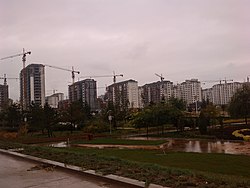Songshan District, Chifeng
Songshan
松山区 • ᠰᠦᠩᠱᠠᠨᠲᠣᠭᠣᠷᠢᠭ | |
|---|---|
District | |
 | |
| Coordinates (Songshan District government): 42°17′59″N 118°54′58″E / 42.2998°N 118.9162°ECoordinates: 42°17′59″N 118°54′58″E / 42.2998°N 118.9162°E | |
| Country | People's Republic of China |
| Region | Inner Mongolia |
| Prefecture-level city | Chifeng |
| Area | |
| • District | 5,629 km2 (2,173 sq mi) |
| Elevation | 567 m (1,860 ft) |
| Population (2019)[2] | |
| • District | 608,883 |
| • Density | 110/km2 (280/sq mi) |
| • Urban | 327,100 |
| Time zone | UTC+8 (China Standard) |
| Postal code | 024005 |
| Website | http://ssq.gov.cn/ |
Songshan District (Mongolian: ᠰᠦᠩ ᠱᠠᠨ ᠲᠣᠭᠣᠷᠢᠭ Сүн шан тоори Süŋ šan toɣoriɣ; simplified Chinese: 松山区; traditional Chinese: 松山區; pinyin: Sōngshān Qū) is a district of the city of Chifeng, Inner Mongolia, China.[1] The district spans 5,629 square kilometers,[1] and has a population of 608,883 as of 2019.[2]
Administrative divisions[]
The district is divided into seven subdistricts, nine towns, and five townships.[1][3] These township-level divisions are then further divided into 244 administrative villages, 44 urban residential communities, and 3 rural residential communities.[3]
| English Name | Hanzi | Division Type | Notes |
|---|---|---|---|
| 振兴街道 | Subdistrict | Seat of District Government | |
| Xiangyang Subdistrict | 向阳街道 | Subdistrict | |
| 松州街道 | Subdistrict | ||
| 铁东街道 | Subdistrict | ||
| 玉龙街道 | Subdistrict | ||
| 兴安街道 | Subdistrict | ||
| 全宁街道 | Subdistrict | ||
| 穆家营子镇 | Town | ||
| 初头朗镇 | Town | ||
| 大庙镇 | Town | ||
| 王府镇 | Town | ||
| 老府镇 | Town | ||
| 哈拉道口镇 | Town | ||
| 上官地镇 | Town | ||
| 安庆镇 | Town | ||
| 太平地镇 | Town | ||
| Dangpudi Manchu Ethnic Township | 当铺地满族乡 | Ethnic Township | Songshan's sole Ethnic Township |
| 夏家店乡 | Township | ||
| 城子乡 | Township | ||
| 大夫营子乡 | Township | ||
| 岗子乡 | Township |
Geography[]
Songshan District is bordered by Ar'horqin Banner to its east, Weichang Manchu and Mongol Autonomous County to its west, Yuanbaoshan District and Hongshan District to its south, Ongniud Banner to its north, Hexigten Banner to its northwest, and Harqin Banner to its southwest.[1]
Climate[]
During 2018, the district experienced an average temperature of 8.9 °C (48.0 °F), with a maximum temperature of 36.1 °C (97 °F), and a minimum temperature of −24.2 °C (−12 °F).[4] The district experienced 2783.5 hours of sunshine, 208 frost-free days, and 381.9 millimeters of precipitation.[4]
Demographics[]
As of 2019, the district's registered population is 608,883, an increase of 8,699 from 2018.[2] Of this, there are 314,013 reported males and 294,870 reported females.[2] The district has a crude birth rate of 11.2 per 1,000, and a crude mortality rate of 3.3 per 1,000, resulting in a rate of natural increase of 7.9 per 1,000.[2] There are 604,400 permanent residents, an increase of 1,500 from 2018, of which, the urban population is 327,100.[2]
Ethnicity[]
| Ethnicity | Population | Percentage |
|---|---|---|
| Han Chinese | 423,496 | 69.55% |
| Mongol | 136,487 | 22.42% |
| Manchu | 44,045 | 7.23% |
| Hui | 4,015 | 0.66% |
| Others | 840 | 0.14% |
| Total | 608,883 | 100.00% |
Economy[]
Songshan's economy reached a GDP of 27.05 billion yuan in 2019, with its primary sector accounting for 18.0% of GDP, its secondary sector accounting for 22.6% of GDP, and the tertiary sector accounting for 59.4% of GDP.[5]
As of 2019, urban residents had a per capita disposable income of 36,168 yuan, and rural residents had a per capita disposable income of 16,555 yuan.[5][6] Retail sales in 2019 totaled 15.04 billion yuan.[5]
The area is home to a number of gold mines.[1] Other mineral deposits in Songshan include silver, copper, iron, lead, limestone, coal, fluorite, and perlite.[1]
Transportation[]
Major roadways which pass through Songshan District include China National Highway 111, China National Highway 305, China National Highway 306, the G16 Dandong–Xilinhot Expressway, and the G45 Daqing–Guangzhou Expressway.[1]
The Beijing–Tongliao railway, , and the (Chinese: 赤沈铁路) pass through Songshan.[1]
References[]
- ^ a b c d e f g h i j 松山区概况地图 (in Chinese (China)). XZQH.org. 2013-04-09. Retrieved 2020-06-01.
- ^ a b c d e f g 2019年松山区政区与人口基本情况. Songshan District People's Government. 2020-04-24. Archived from the original on 2020-06-01. Retrieved 2020-06-01.
- ^ a b 行政区划. Songshan District People's Government. 2020-04-24. Archived from the original on 2020-06-01. Retrieved 2020-06-01.
- ^ a b 2018年气候概况. Songshan District People's Government. 2019-06-05. Archived from the original on 2020-06-01. Retrieved 2020-06-01.
- ^ a b c 2019年经济运行情况. Songshan District People's Government. 2020-02-23. Archived from the original on 2020-06-01. Retrieved 2020-06-01.
- ^ 2019年人民生活和社会保障概况. Songshan District People's Government. 2020-04-24. Archived from the original on 2020-06-01. Retrieved 2020-06-01.
- County-level divisions of Inner Mongolia
- Chifeng
